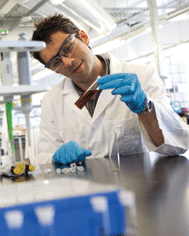Themed issue: synthesis of polymeric nanomaterials for medicine
Cyrille
Boyer
ab and
Thomas P.
Davis
cd
aAustralian Centre for NanoMedicine, The University of New South Wales, Sydney, Australia. E-mail: cboyer@unsw.edu.au
bCentre for Advanced Macromolecular Design, School of Chemical Engineering, The University of New South Wales, Sydney, Australia
cMonash Institute of Pharmaceutical Sciences, Monash University, Parkville, Melbourne 3052, Australia. E-mail: thomas.p.davis@monash.au
dSchool of Chemistry, University of Warwick, UK
These advances in polymer science have largely been made possible by the emergence of controlled/living radical polymerization techniques, including atom transfer radical polymerization (ATRP), reversible addition fragmentation transfer (RAFT) and nitroxide mediated polymerization (NMP), and efficient organic reactions, including copper azide alkyne click chemistry and thiol–ene reactions. The preparation of precisely defined polymeric nanostructures has been successfully described by a combination of these techniques. Thus, the synthesis of complex polymeric architectures, previously inaccessible by conventional free radical polymerization, has come about through the development of more demanding methods such as ionic polymerization.
Ionic polymerization allows chemists good control of the molecular weight and polymer distribution, but this technique is only applicable to a comparatively small set of polymerizable molecules, and requires specific skills and training. In contrast, the development of controlled radical polymerization (CRP) has popularised “polymer chemistry” by the use of commercially available compounds (without the need for further purification) and inexpensive setup. These techniques afford the synthesis of complex polymeric architectures, including core crosslinked star polymers, graft, and block copolymers.
The introduction of hydrophobic, hydrophilic, pH- and temperature-responsive monomers into polymer chains allows for self-organization of these macromolecules into more complex nano-objects, including micelles, vesicles and capsules, which have been developed to store therapeutic compounds. For example, the introduction of photo-, pH-, enzymatic and temperature responsive groups offers opportunities to trigger and control drug release or the assembly/disassembly of nano-objects via an external trigger.
This issue proposes a collection of communications, reviews and articles by world leaders in the polymer community and their developments of new polymeric nanomaterials for medical applications. The preparation of original macromolecules and responsive polymers via controlled polymerization and click chemistry is discussed. This issue focuses on the following topics: (i) functionalization of macromolecules, (ii) preparation of macromolecules, (iii) self-assembly of these macromolecules into more complex nano-objects, and (iv) preparation of stimuli-responsive polymeric nanoparticles.
The direct functionalization of macromolecules with therapeutic compounds, such as chemotherapy drugs was investigated by Cheng and co-workers (DOI: 10.1039/c3py01245j). In this approach, camptothecin anti-cancer drugs were conjugated to poly(lactic acid) via a hydrolysable bond. Nicolas and co-authors (DOI: 10.1039/c3py01384g) reviewed the field of anticancer polymer prodrug nanocarriers, while an overview of the use of well-known N-poly(hydroxypropyl methacrylamide) polymers for bioapplications was proposed by Sumerlin et al. (DOI: 10.1039/c3py01279d). Finally, new strategies for the conjugation of protein and peptides onto polymers and polymeric nanoparticles have been demonstrated by MacKay et al. (DOI: 10.1039/c3py00537b) and Stenzel et al. (DOI: 10.1039/c3py01412f).
New routes for the design of complex macromolecules are also an active research field. In this issue, the preparation of new macromolecules containing chiral groups or cyclodextrin for the synthesis of asymmetric star copolymers is reported by Liu et al. (DOI: 10.1039/c3py01278f) and Wan et al. (DOI: 10.1039/c3py01297b), while Qiao's group proposes the synthesis of amphiphilic multi-star polymers with highly grafted pyrene connectors for the delivery of pirarubicin (DOI: 10.1039/c3py01160g). These complex macromolecules can be directly employed for therapeutic applications or self-assembly into nanoparticles.
Recently, responsive polymeric nanoparticles have been designed for the controlled release of therapeutic compounds via an external stimulus or for their disassembly. For instance, the introduction of new functional groups, including boronic acid, in polymeric nanostructures with the ability to interact specifically with biological compounds, such glucose, is reviewed by Shi et al. (DOI: 10.1039/c3py01202f), while Zhang et al. (DOI: 10.1039/c3py01190a) prepared glucose-responsive microgels by the introduction of substituted phenylboronic acid groups. The specific interactions of boronic acid with glucose allow the synthesis of responsive polymeric microparticles, including for the treatment of diabetes. Light is another trigger, with a growing interest in polymer sciences and in medical applications, as it allows controlled release in both time and space. Dong et al. (DOI: 10.1039/c3py00533j) proposed the synthesis of light responsive amphiphilic dendrimers, which are able to disassemble under near infrared light. In another example, Kiick et al. (DOI: 10.1039/c3py01269g) synthesized polymer nanogels crosslinked via a photo-triggered Michael addition reaction. Interestingly, light can be also employed for therapy, as is the case in the use of conjugated polymers to improve photothermal therapies undertaken by the group of Liu (DOI: 10.1039/c3py01196h). Besides light-responsive groups, pH and redox-responsive groups have successfully been incorporated into polymeric nanoparticles for the delivery of nucleic acid by Alexander et al. (DOI: 10.1039/c3py00744h) and the delivery of chemotherapy drugs by Kwon Oh et al. (DOI: 10.1039/c3py00852e), Thayumanavan et al. (DOI: 10.1039/c3py01277h) and Lammers et al. (DOI: 10.1039/c3py01097j). These nanoparticles allow a controlled release of therapeutic compounds at low pH or in a reductive environment. The combination of pH- and redox-sensitive groups into one nanoparticle permits the manipulation of the drug release via two different stimuli as demonstrated by Kwon (DOI: 10.1039/c3py01112g). Finally, the design of nanoobjects by self-assembly of polymers to prepare responsive micelles has also been investigated using voltage-responsive macromolecules (DOI: 10.1039/c3py01192e) by Yuan et al. In conclusion, we hope that this special issue will give an overview of the potential applications of polymeric nanomaterials for medical applications.
| This journal is © The Royal Society of Chemistry 2014 |


